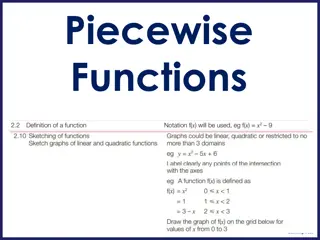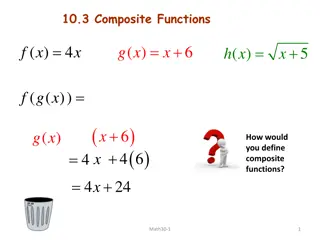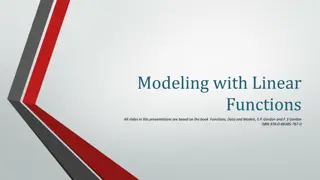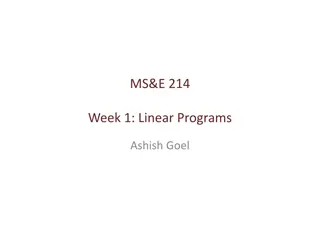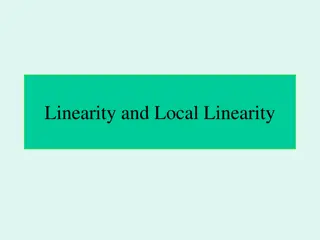Understanding Linear Functions in Mathematics
Linear functions play a crucial role in mathematics, focusing on elements like rate of change and initial value. Through examples involving daily car rental costs and profit from selling birdhouses, this content explores the concept of linear functions and how they are applied in real-life scenarios. From determining the rate of change to creating linear equations, this comprehensive guide helps in understanding and solving problems related to linear functions.
Download Presentation

Please find below an Image/Link to download the presentation.
The content on the website is provided AS IS for your information and personal use only. It may not be sold, licensed, or shared on other websites without obtaining consent from the author. Download presentation by click this link. If you encounter any issues during the download, it is possible that the publisher has removed the file from their server.
E N D
Presentation Transcript
MATH 1311 Section 3.2
Linear Functions Linear Functions always pay special attention to two main elements: The rate of change. The initial value.
Linear Functions Linear Functions always pay special attention to two main elements: The rate of change Slope The initial value Y-Intercept Linear Functions will be in the form of: f(x) = (Slope)x + (Y-Intercept) or f(x) = mx + b
Example: A car rental company models its daily price structure based on a linear function. There is a flat fee of $150 with an additional charge of $0.05 per mile driven. Write an equation for the daily price structure. a. Determine the rate of change. b. Determine the initial value. c. Create a linear equation.
How much would it cost to rent a car for the day when you are driving 250 miles? 350 miles? How many miles would you have driven for a total bill of $220?
Example: It costs $250 to buy materials to make bird houses. You can sell each birdhouse of $15. Create the linear equation for profit. a. Identify the rate of change and the initial value. b. Write your linear function. c. Determine the value of the x-intercept. What does this value mean? d. Determine the value at x = 200. What does this value mean?
Popper 13: A taxi cab charges a flat fee of $5 and an additional charge of $0.10 for every mile. 1. What is the fixed cost? a. 5 2. What is the incremental cost? a. 5 3. What is the linear equation for the cost of a taxi ride? a. y = 0.50x b. y = 0.10 + 5x b. 0.10 b. 0.10 c. y = 0.10x + 5 d. y = 0.15x 4. What is the cost of taking a 7 mile ride? a. $5.70 b. $7.50 c. $7.70 d. $0.70 5. How many miles would you travel if your fare was $6.20? a. 8 miles b. 10 miles c. 12 miles d. 14 miles
Linear Equations from Data: A hotel company charges guests based on a linear function. A guest staying 3 nights will pay $450 and a guest staying 6 nights will pay $750. a. Write the two pieces of data as coordinate points. b. Determine the slope of the linear function. c. Determine the y-intercept of the linear function. d. Write the linear function. e. Determine how much a guest staying 8 nights will have to pay.
A water company charges a flat monthly fee and an cost for gallons of usage. One month, you used 2500 gallons and had a bill of $210. A different month, you used 3200 gallons and had a bill of $259. Create 2 coordinate points. Find the slope. Find the y-intercept. Find the equation of the line. Determine what the monthly cost would be for usage of 3000 gallons.
Popper #14: The amount of property tax a person pays is a linear model based on the square footage of their home. A home of 2500 sq ft will pay $1500 annually and a home of 3000 sq ft will pay $1600. 1. Determine the slope of the linear function. a. 500 b. 0.2 c. 100 2. Determine the y-intercept of the linear function. a. 1000 b. 1500 c. 2000 3. Determine the equation of the linear function. a. f(x) = 0.2x + 2000 b. f(x) = 100x + 1000 c. f(x) = 0.2x + 1000 4. How much tax would a home of 5000 sq ft need to pay? a. $3500 b. $2500 c. $3000 d. 0.1 d. 2500 d. f(x) = 500x + 1000 d. $2000






